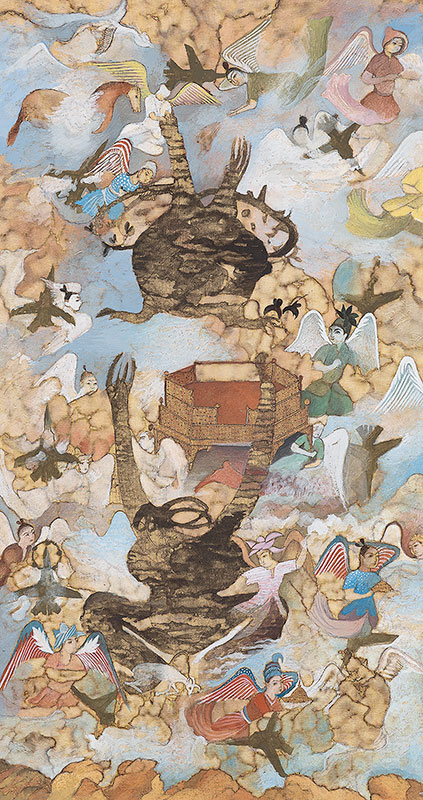
Sikander returned to the same Persian painting here that was the base for Sly Offering (on display nearby). Painted just as the United States was ramping up its response to the 9/11 attacks, No Fly Zone imbues the monstrous protagonists of Sikander’s early vocabulary with new political relevance. As scholar Sadia Abbas has noted, the empty throne in this painting—one of Sikander’s favorite motifs of the early 2000s—“marks a crisis of postcolonial sovereignty in an era of revived imperialism.” The jets and angels clad in red, white, and blue wings make clear the central role played by the United States.
Shahzia Sikander (born 1969)
No Fly Zone, 2002
Watercolor, gravure, and inkjet outline, on wasli paper
Collection of Mitzi and Warren Eisenberg
© Shahzia Sikander. Courtesy: the artist, Sean Kelly, New York and Pilar Corrias, London.
Shazia Sikandar: In the center of this painting, you may recognize these ambiguous forms. If you look closely, they are evocative of the female body and they are anchoring the entire composition, even maybe disrupting a certain cosmic order of patriarchy, sovereignty. This work is a series that I did in the early 2000s when I was reflecting upon war, women and power, violence and capitalism, the drama of all these movements that are at the heart of a global crisis. There's also reference to many who are forced to migrate, the refugees, those from countries that are always on the no-fly list. As a Pakistani national, I was unable to travel outside of the US for more than eight years when my green card application was pending or lost in that abyss. So I was making also a statement on these questions of who controls power? How is that particular armature upheld? What is that space between the migrant and the immigrant, the citizen and the foreigner, how it's always in flux, a space where more and more communities are now defining that space on their own terms, and reflecting more of the complex, dynamic and evolving world that we all live in.
